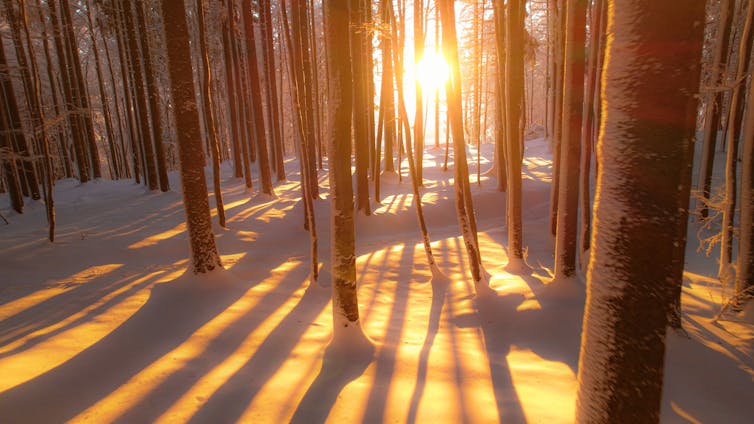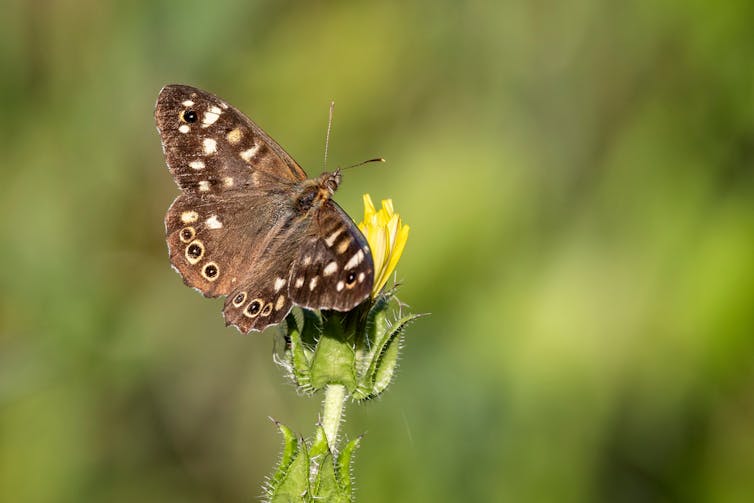
You are standing in a forest in the middle of winter and the temperature has dropped below zero. The ground is covered in snow and the trees and bushes are naked. The insects that normally fly or crawl in warmer weather are nowhere to be seen.
You might assume that insects do not survive the seasonal shift. After all, temperatures are too low for them to forage and the plants or other insects they’d eat are scarce anyway.
But that is not the case. Actually, they are still all around you: in the bark of the trees and bushes, in the soil, and some may even be attached to plants underneath the snow. Snow, as it turns out, is a rather good insulator – almost like a blanket.
The insects are hibernating. Scientists call this a “diapause” and it is how insects, which in most cases cannot generate their own heat like we mammals can, survive the cold winter months.
Winter is coming…
Insects have to prepare for winter before the temperature gets too low. For some species, hibernation is a part of life. These species have one generation a year, and every individual will experience winter and hibernate no matter the conditions.
However, most insects only get the cue to hibernate from their environment. This allows a species to have several generations a year in which only one experiences winter. Those species must somehow foresee winter’s approach.
So how do they do it? Temperature is not a particularly reliable signal. Although temperatures get colder towards winter, they can vary a lot from week to week. Another environmental factor can be trusted to be the same every year: day length.

A great variety of insects interpret the shortening days as their cue to prepare for hibernation, unless there is still time for another generation before winter descends. Take the speckled wood butterfly. This butterfly can sense the lengths of days as a larva (it is still not fully known how) and if they are suitably short, it gains extra weight and, as a pupa (or chrysalis), hibernates.
Correctly assessing when winter will arrive is crucial for survival. If an insect fails to make the right decision on time it may freeze or starve, or spend all of its hard earned energy before it can safely emerge from hibernation.
A long winter’s gnat
Hibernation entails several strategies that have allowed this vast class of animals, comprising approximately 5.5 million species, to cope with the cold far from Earth’s balmy equator.
Some insects hibernate in places that conceal them from low temperatures while others undergo changes within their bodies to either avoid or tolerate freezing. Our friend the speckled wood butterfly, after gaining weight as a larva, will search for a suitably sheltered spot to bed down in its forest habitat – perhaps on the grass (which it eats the rest of the year) that will become covered in snow.
There is almost no food available at this time of year and insects generally do not eat during their hibernation. Winter can last for months, so insects have evolved two strategies: gain additional weight before winter and consume this energy store slowly by lowering their metabolic rate.
Many insects live their entire life cycle (from egg to larva, pupa and adult) within a few months to a year. Losing months during winter is significant. And so, insects simply pause their development during hibernation. Which life stage species hibernate in differs from species to species. But the speckled wood butterfly, found across Europe and North Africa, turns into a pupa just before winter and develops into a butterfly several months later in spring.

Change is in the air
Rising global temperatures caused by burning fossil fuels, animal agriculture and deforestation, among other things, have resulted in shorter and warmer winters.
For insects that can adapt to these changes fast enough, it leaves an opportunity to expand northwards and produce more generations per year where they currently are. Some species have managed to do this while others can’t – entomologists are expending great effort to understand why.
The challenges of adapting to warmer winters are manifold. Temperatures drop later and later in the season, but days shorten as consistently as they ever did. This mismatch can trick insects into making the wrong decision. If this happens to too many insects, a species can go locally extinct.
Studies suggest that some insects can change the day length they use to diagnose winter’s approach relatively quickly. However, it is not known if all species will be so capable.
Energy consumption in insects is also temperature-dependent. As winters warm, an insect risks depleting its energy stores before it can terminate hibernation.
Higher temperatures during winter also mean less snow, which, somewhat ironically, means that some species cannot conceal themselves from the cold.
Expanding northwards can be a somewhat limited opportunity. The food source or habitat an insect relies on may not be available in its new home, especially if the species live offs just a few plants or its habitat is not found further north.
With more research into the factors influencing how different insects adapt to higher temperatures during winter, scientists could predict which species will need more urgent help from conservationists – and what form that help should take.
Next time you are standing in a forest on a cold winter day, think about how amazing it is that hibernating insects are surviving, for several months at a time, in a climate where they would otherwise perish.

Don’t have time to read about climate change as much as you’d like?
Get our award-winning weekly roundup in your inbox instead. Every Wednesday, The Conversation’s environment editor writes Imagine, a short email that goes a little deeper into just one climate issue. Join the 40,000+ readers who’ve subscribed so far.
Anna Brødsgaard Shoshan does not work for, consult, own shares in or receive funding from any company or organisation that would benefit from this article, and has disclosed no relevant affiliations beyond their academic appointment.
This article was originally published on The Conversation. Read the original article.







